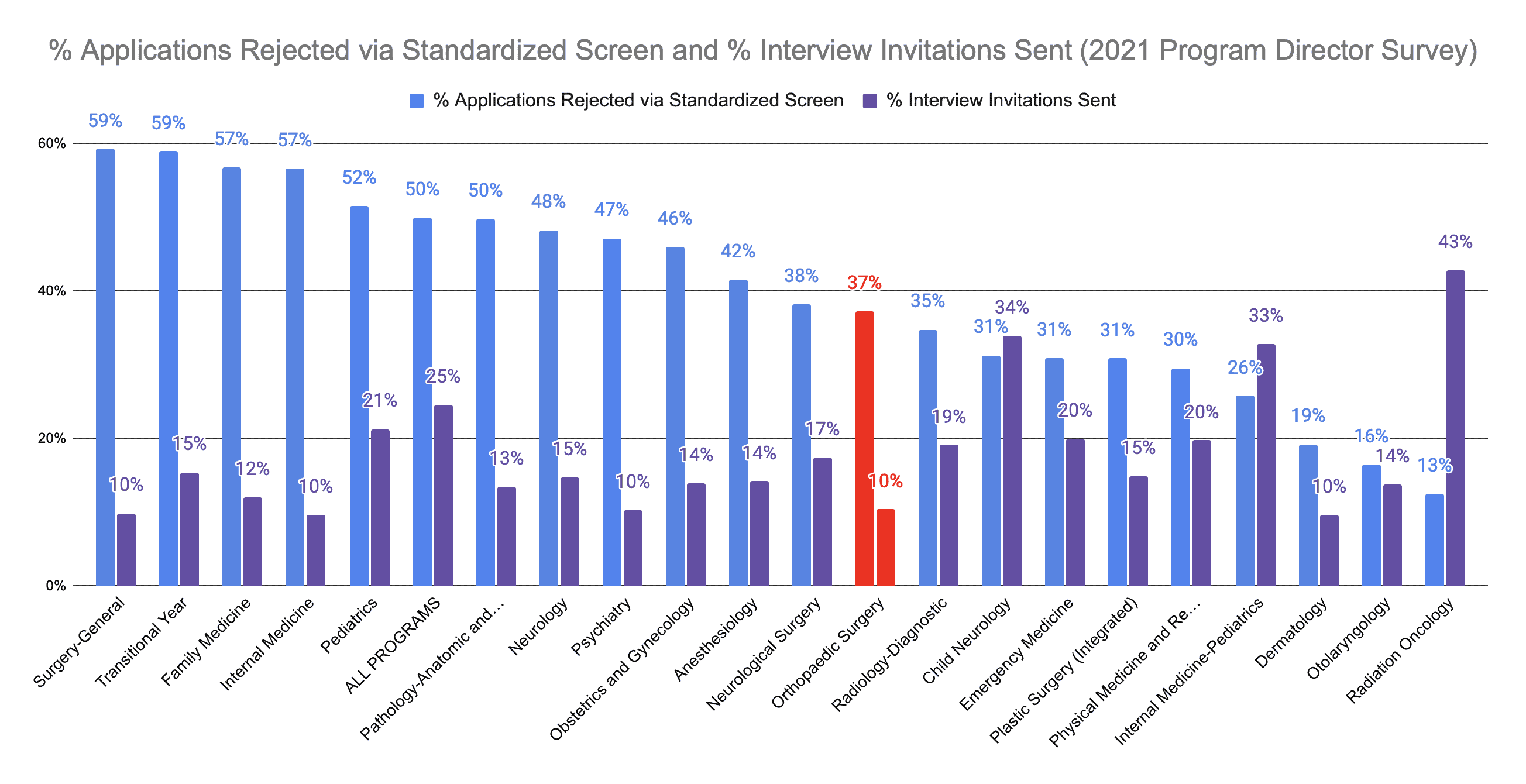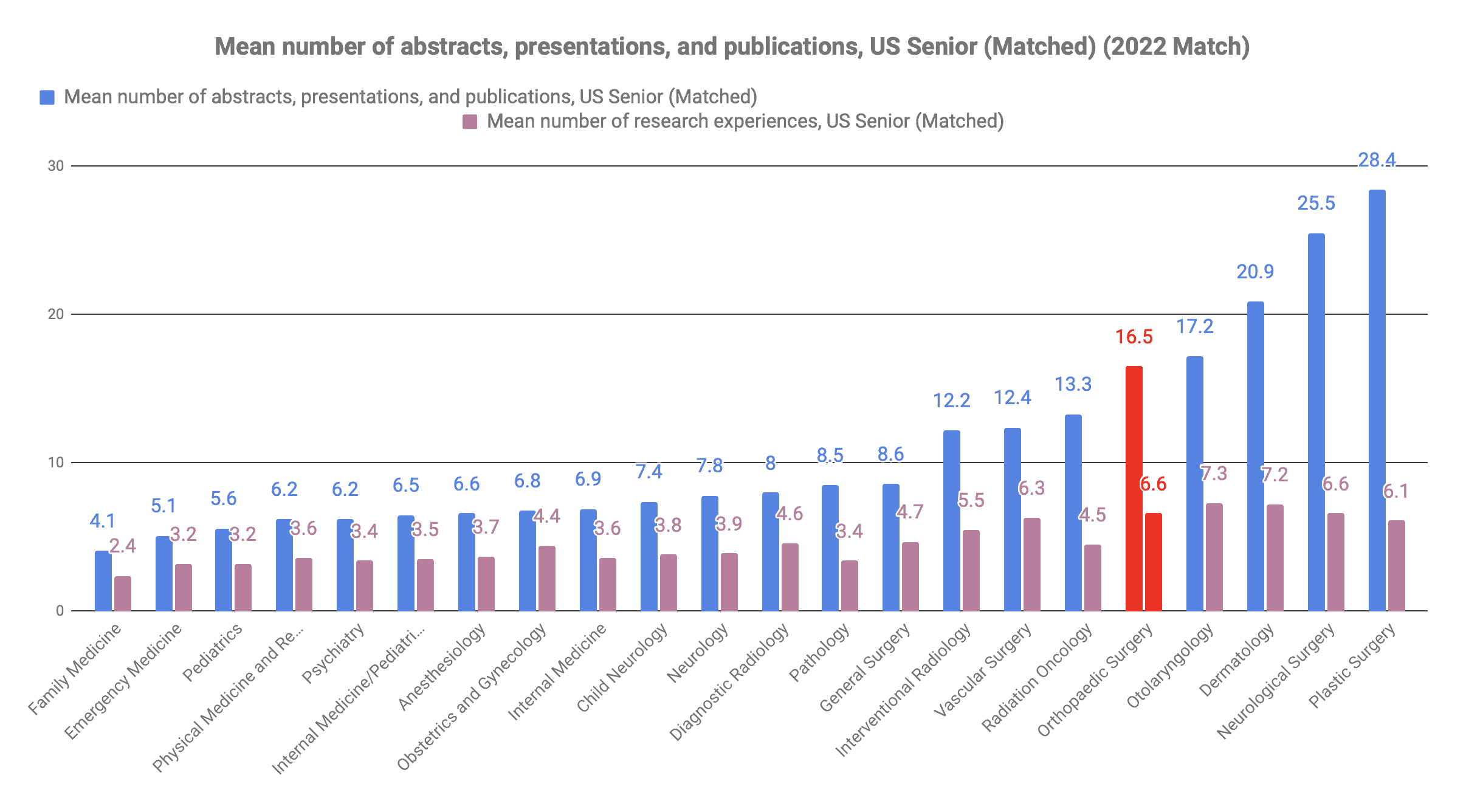Physical Address
But how much of an advantage – or disadvantage – does an MPH (Master of Public Health) or MBA (Master of Business Administration) confer when applying into orthopaedic surgery? Not much, it turns out. In fact, the match rate for US seniors with other degrees was 8% lower than the rate for those with other degrees.
Is Orthopaedic Surgery Competitive in 2023?
Cardiology is key for impressive USMLE scores. Master cardiology from a Harvard-trained anesthesiologist who scored USMLE 270 with these 130+ high-yield flash cards. You’ll be begging for cardio questions – even if vitals make you queasy.
it’s free!
Want FREE Cardiology Flashcards?
Cardiology is key for impressive USMLE scores. Master cardiology from a Harvard-trained anesthesiologist who scored USMLE 270 with these 130+ high-yield flash cards. You’ll be begging for cardio questions – even if vitals make you queasy.
Is orthopaedic surgery competitive? How important are the USMLEs, research, med school reputation, and AOA membership for matching into orthopaedic surgery? Is orthopaedic surgery IMG-friendly? And what is the DO match rate for orthopaedic surgery programs?
In this article, you’ll learn everything about orthopaedic surgery’s competitiveness in 2022. In the process, you’ll learn what to focus on – and what not to – to maximize your chances of matching into this desirable specialty.
Summary:
- Orthopaedic Surgery Overall Competitiveness: High
- Research Importance: Moderate
- USMLE Importance: High
- Importance of Attending Top 40 Med School: Moderate
- Importance of Class Rank / Obtaining AOA (Med School Honors): High
Table of Contents
Is Orthopaedic Surgery Competitive in 2022?
One way to assess the competitiveness of a specialty is to look at the match rate – the % of people who apply who end up matching into their preferred specialty.
Among US Seniors, the unmatched percentage was 34.2%, making it highly competitive among US residencies. The match rate for orthopaedic surgery is slightly better than plastic surgery which is the most competitive specialty. However, orthopaedic surgery is considerably more competitive than pediatrics, emergency medicine, child neurology, or even radiation oncology in the 2022 match.
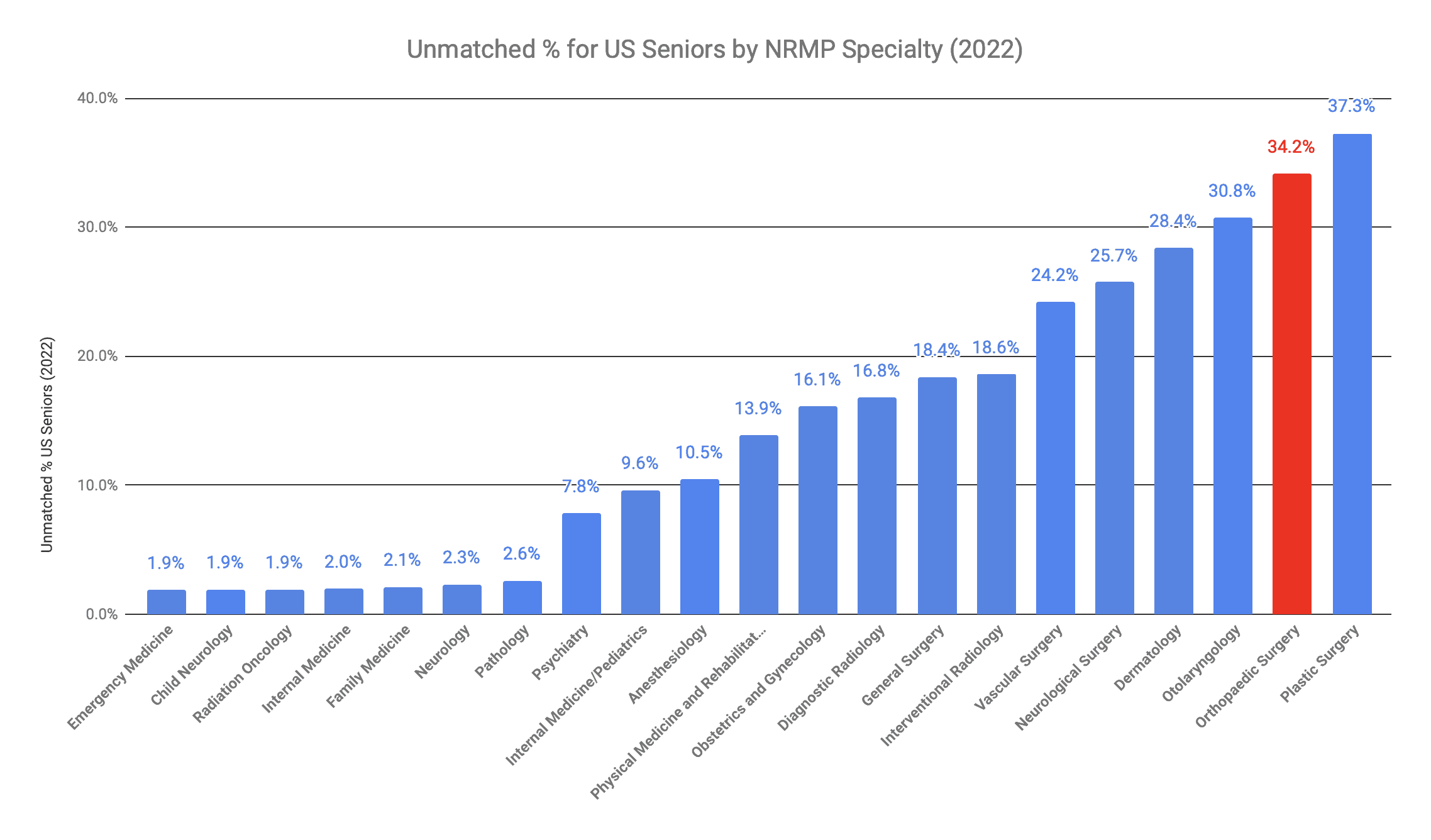
Orthopaedic Surgery Match Rate
What is the Orthopaedic Surgery match rate for US seniors, DO seniors, and IMGs? The “match rate” is the % of people who applied to a particular specialty as their preferred specialty who successfully matched into the specialty.
- US Senior Orthopaedic Surgery Match Rate (2022 Match): 65.8%
- DO Senior Orthopaedic Surgery Match Rate (2022 Match): 56%
- US IMG Orthopaedic Surgery Match Rate (2022 Match): 26%
- Non-US IMG Orthopaedic Surgery Match Rate (2022 Match): 55%
See below for more on matching into Orthopaedic Surgery as a DO or IMG.
Orthopaedic Surgery Match Statistics 2022
In 2022, there were 875 orthopaedic surgery positions available in the NRMP match. A total of 1,435 applicants listed it as their preferred specialty.
In the 2022 Match, orthopaedic surgery ranked #11 for most total positions offered, it had the median number of positions offered by preferred specialty.
- Internal medicine: 9,809 positions
- Family medicine: 4,926 positions
- Pediatrics: 3,016 positions
- Emergency medicine: 2,921 positions
- Psychiatry: 2,047 positions
- Anesthesiology 1,969 positions
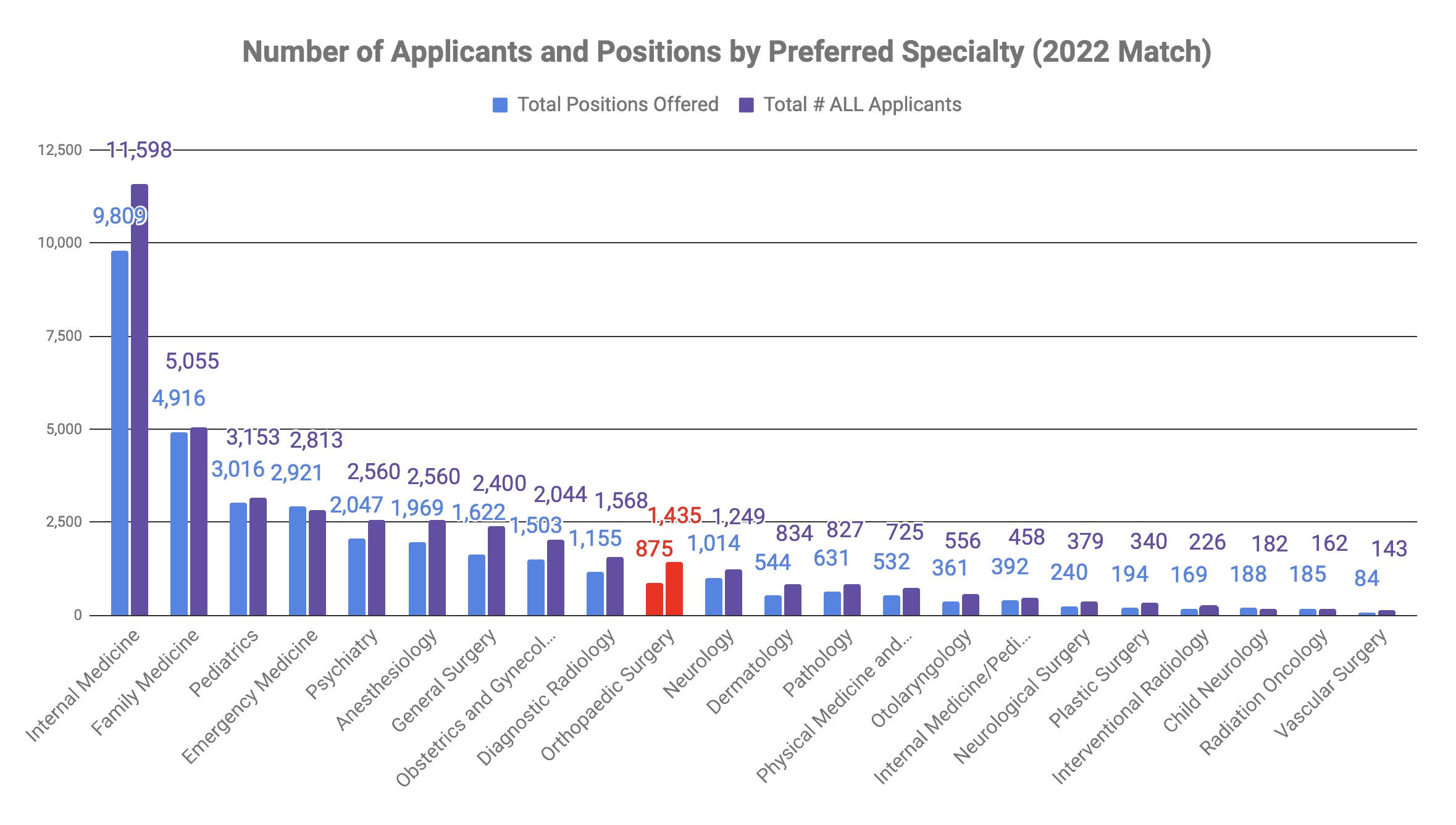
How Many Applicants Receive Interviews in Orthopaedic Surgery?
According to the 2021 Program Director survey, each Orthopaedic Surgery program received 655 applications on average. Other data include:
- Applications received (Orthopaedic Surgery): 655
- Applications rejected based on standardized screen (Orthopaedic Surgery): 244
- Applications receiving holistic review (Orthopaedic Surgery): 366
- Interview invitations sent (Orthopaedic Surgery): 68
- Applicants interviewed (Orthopaedic Surgery): 62
- Applicants ranked (Orthopaedic Surgery): 55
Looking at the percentages, we can see that for the 2021 Match:
- 37% of Orthopaedic Surgery applications were rejected via standardized screen,
- Only 56% of Orthopaedic Surgery applications received a holistic review,
- 10% of Orthopaedic Surgery applications received an interview invitation, and
- 8% of all Orthopaedic Surgery applicants were ranked to match
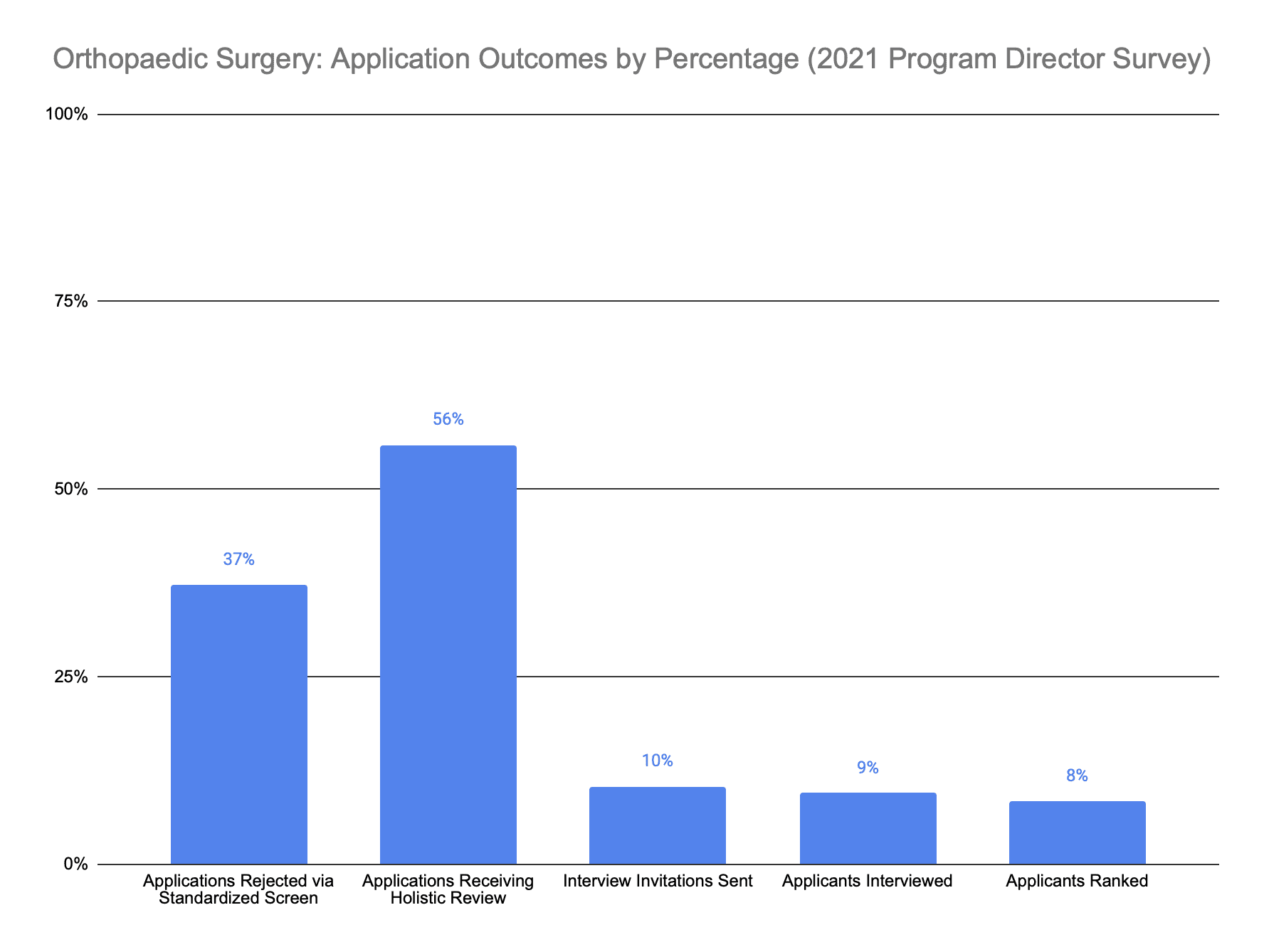
Orthopaedic Surgery is Moderately Reliant on Screens
Orthopaedic surgery relies on standardized screens to weed out applicants. In the 2021 Program Director Survey, orthopaedic surgery PDs respondents reported that 42% of applications were rejected via standardized screen. This ranked near the lower end of residencies.
USMLE Scores for Orthopaedic Surgery
Step 1 scores for orthopaedic surgery for matched US seniors reflect its high competitiveness.
Orthopaedic Surgery Step 1 Scores (Matched Applicants in 2022 Match):
- 25%ile: 242
- Median: 249
- 75%ile: 255
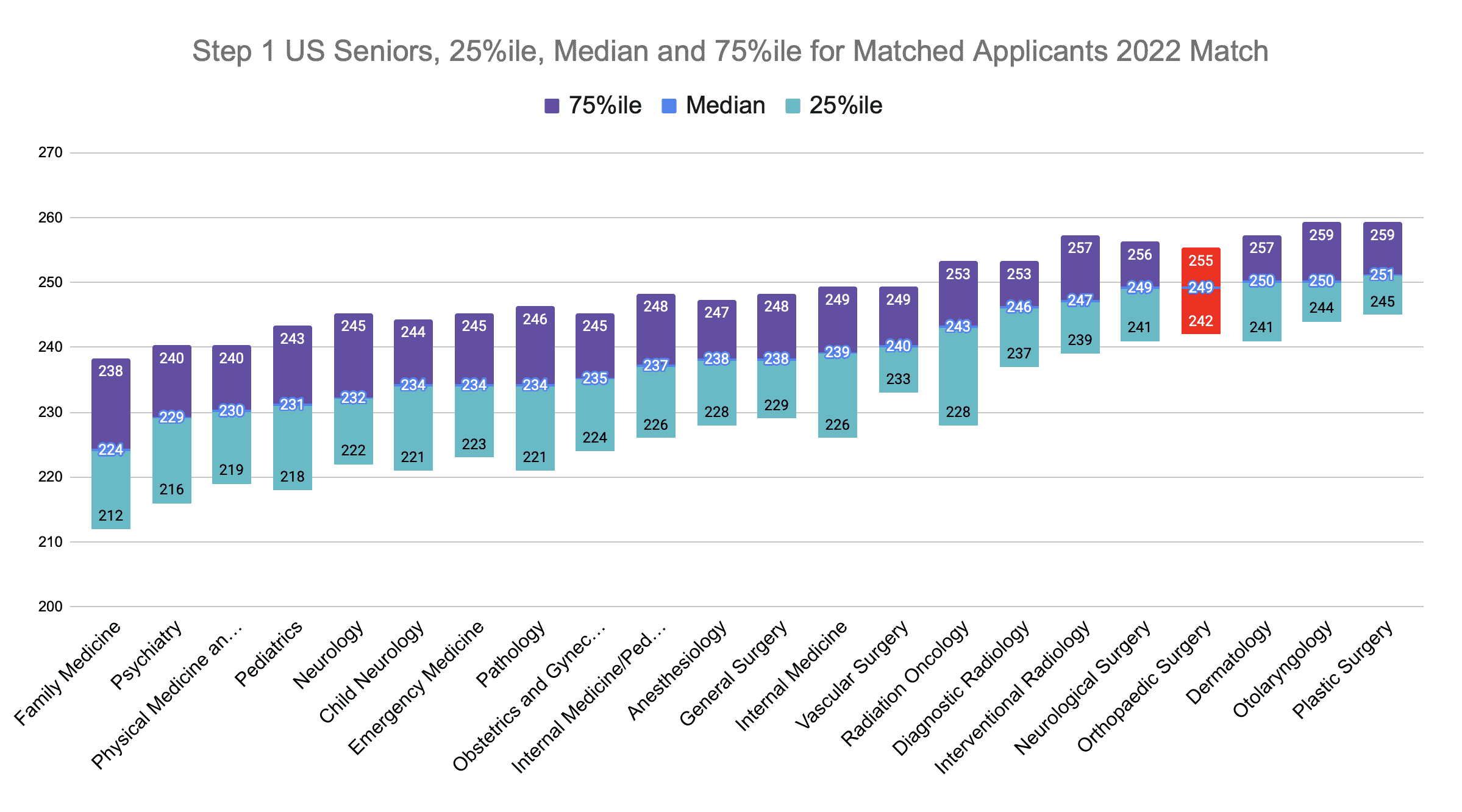
Step 1 Orthopaedic Surgery Scores Are Middle of the Road (2022 Match)
Similarly, Step 2 CK scores for orthopaedic surgery for matched US seniors reflect its high competitiveness.
Orthopaedic medicine Step 2 CK Scores (Matched Applicants in 2022 Match):
- 25%ile: 250
- Median: 257
- 75%ile: 264
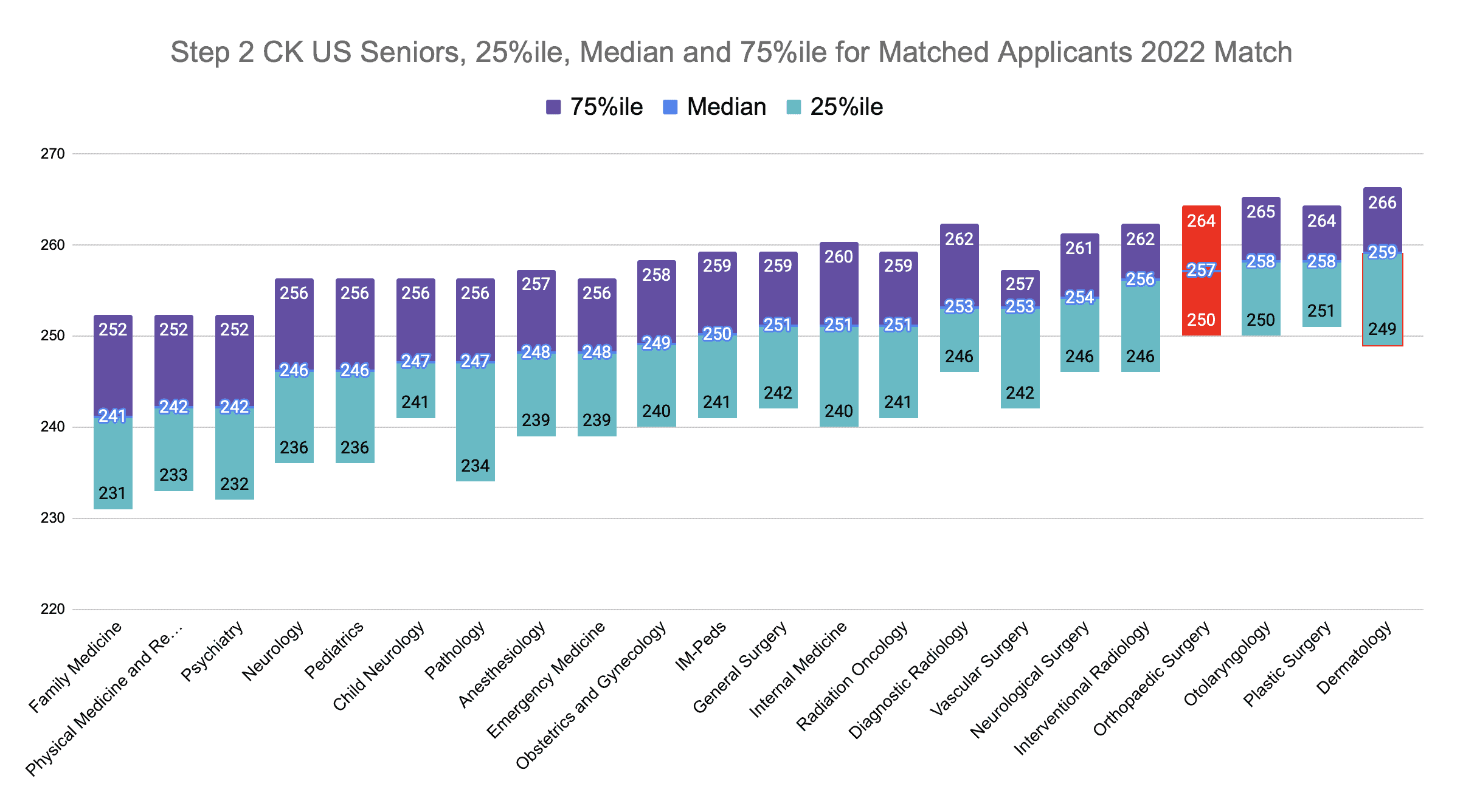
Step 2 CK Orthopaedic Surgery Scores Are Middle of the Road (2022 Match)
See this article for more on USMLE Step 1 and Step 2 CK percentiles for each specialty and the overall percentiles.
Matching into Orthopaedic Surgery as a DO
Matching into Orthopaedic Surgery as a DO is moderately competitive, with a 56% match rate and 13% of spots filled by DO Seniors in the 2022 Match. In 2022, 197 DO seniors applied for Orthopaedic Surgery; 111 matched.
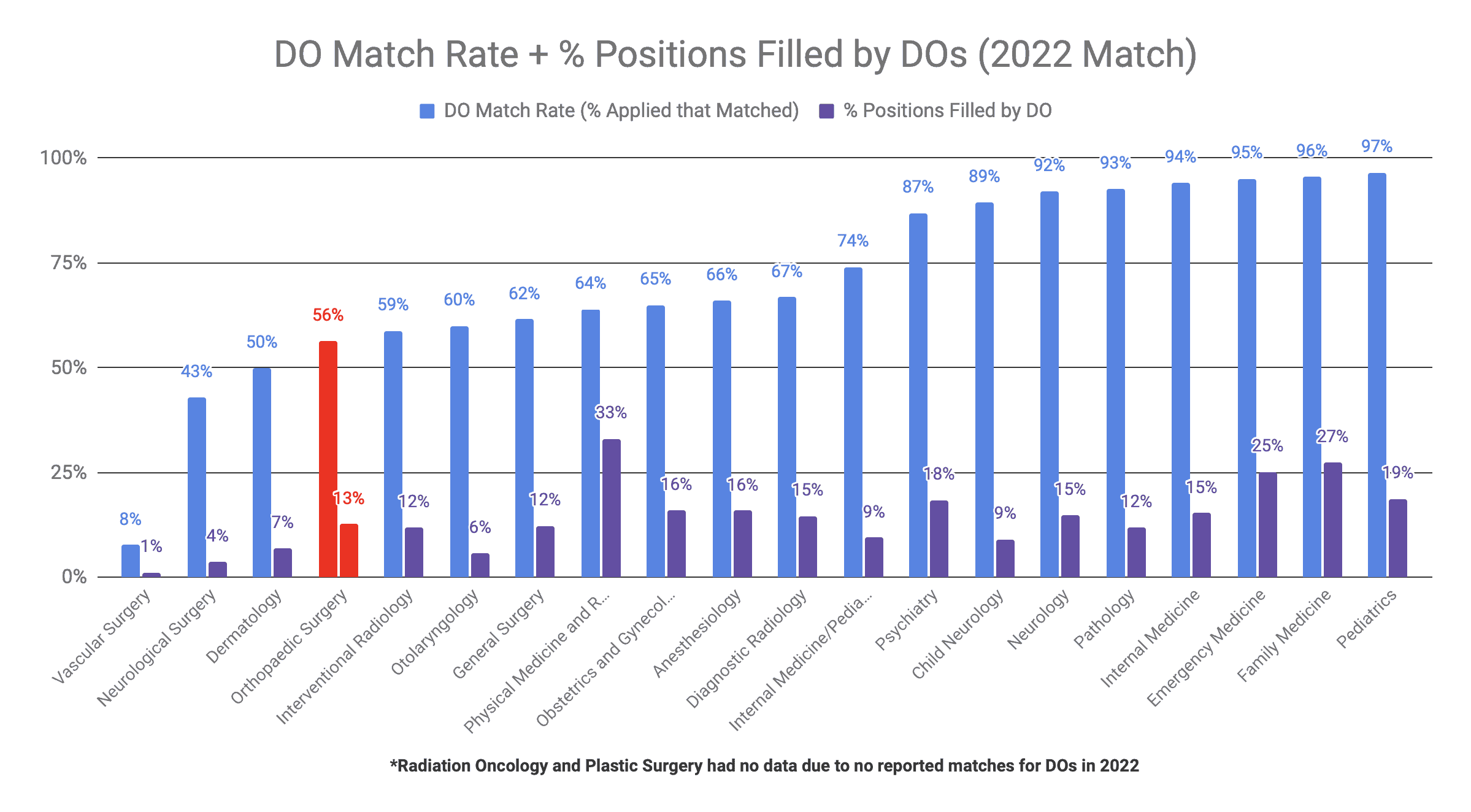
Orthopaedic Surgery is Moderately DO-Friendly (2022 Match)
For more on the most DO-friendly specialties, see this article.
Is Orthopaedic Surgery IMG Friendly?
Orthopaedic Surgery is moderately IMG-friendly, with an overall 37% match rate and 2% of spots filled by IMGs in the 2022 Match. In 2022, 31 US IMGs and 20 non-US IMGs applied to Orthopaedic Surgery; 8 US IMGs and 11 non-US IMGs matched.
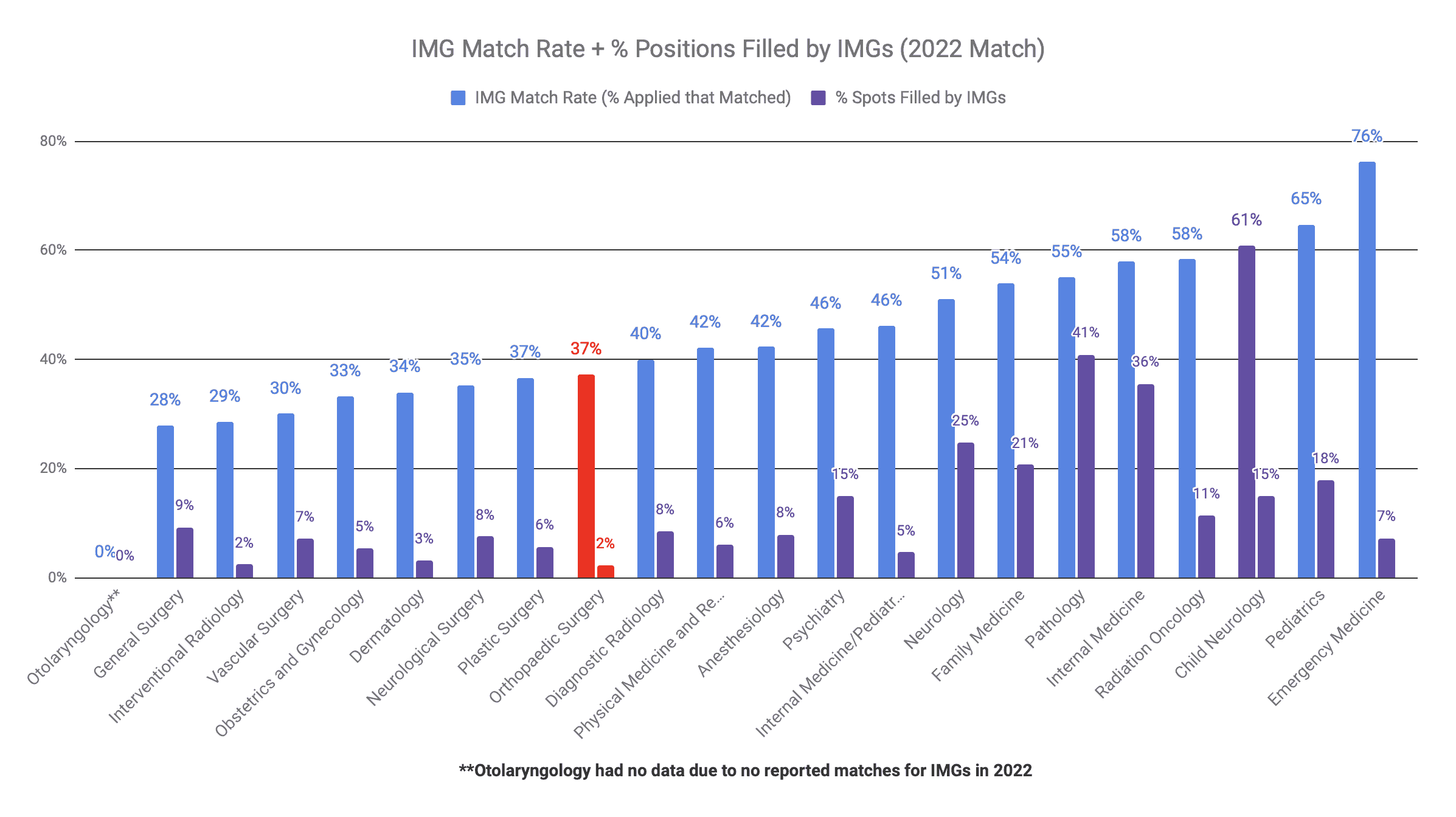
Orthopaedic Surgery is Moderately IMG-Friendly (2022 Match)
We can see that US IMGs had a slightly lower match rate (26%) than non-US IMGs (55%) in Orthopaedic Surgery.
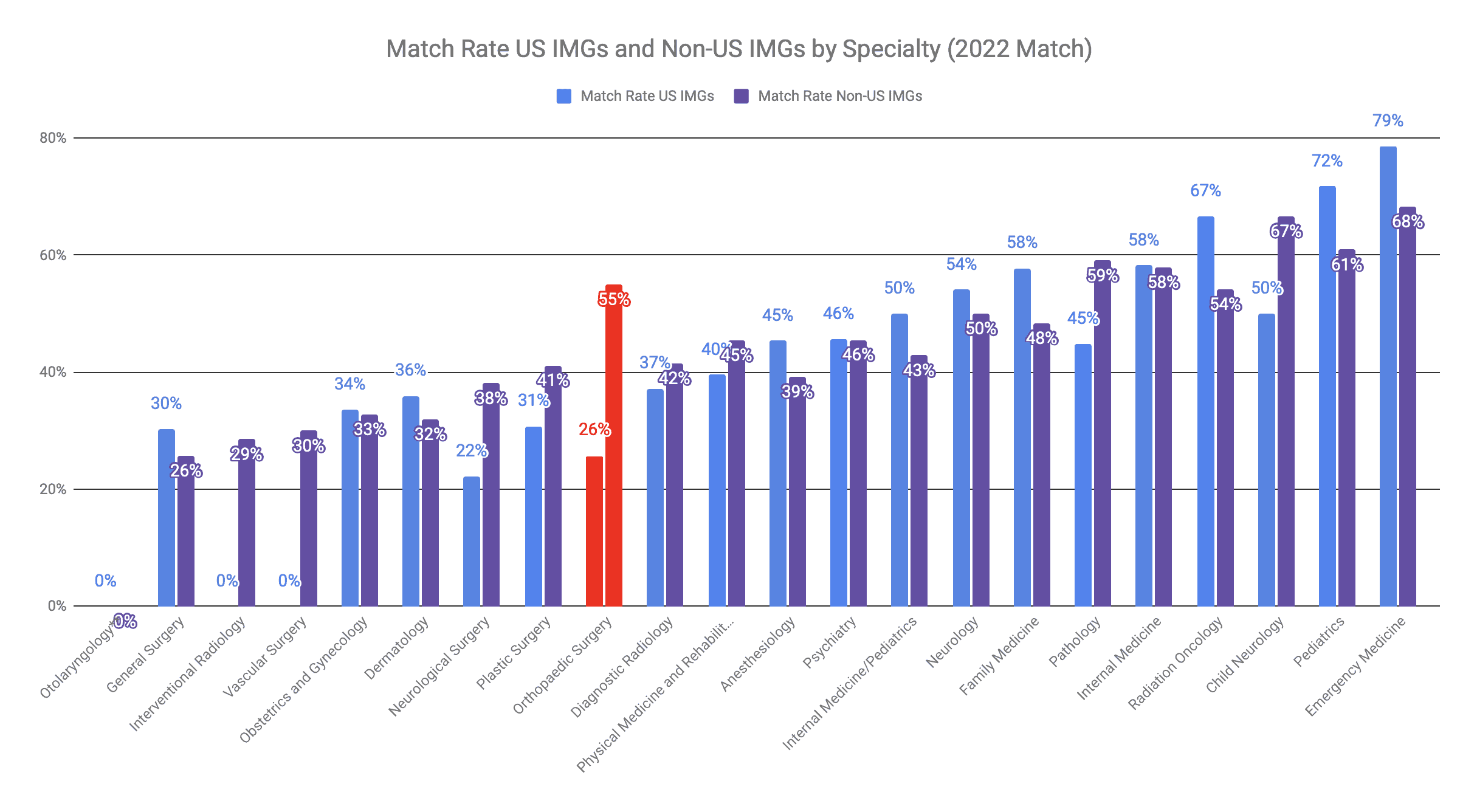
For Orthopaedic Surgery, US IMGs had a slightly lower match rate (26%) than non-US IMGs (55%) in the 2022 Match
For more on the most IMG-friendly specialties, see this article.
Orthopaedic Surgery-Friendly IMG Residency Programs
For a list of the most IMG-friendly orthopaedic surgery programs, see this article.
How Much Do Orthopaedic Surgeons Make per Year? Per Hour?
Orthopaedic surgeons have an average annual salary of $557,000. This can vary dramatically based on practice setting, specialty training, and experience level.
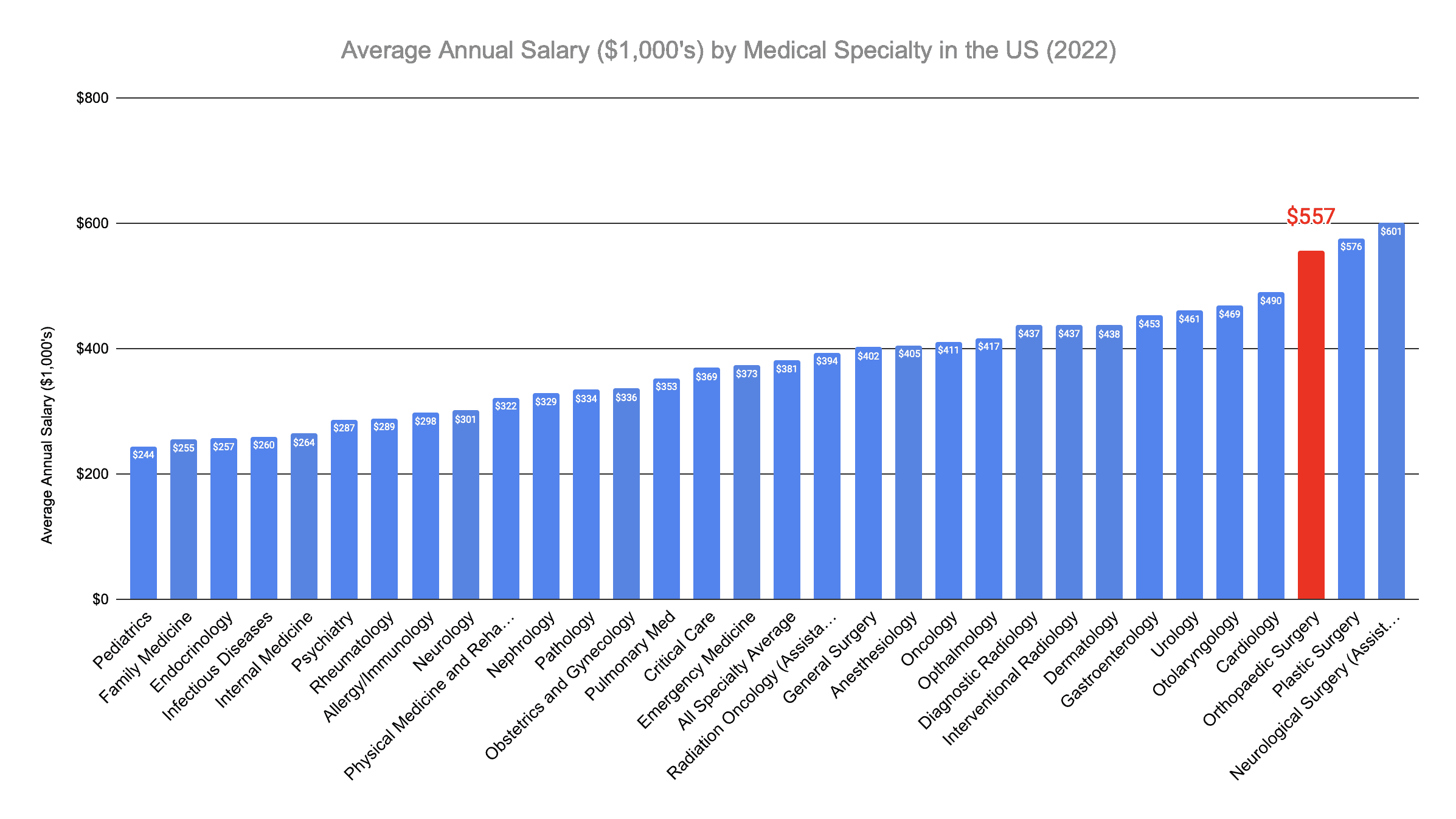
Orthopaedic Surgeons make $557,000 per year on average
However, annual salaries can be misleading. Some specialties work much more than others. By considering the estimated hours worked per year for orthopaedic surgery, we get an estimated hourly salary of $207/hr.
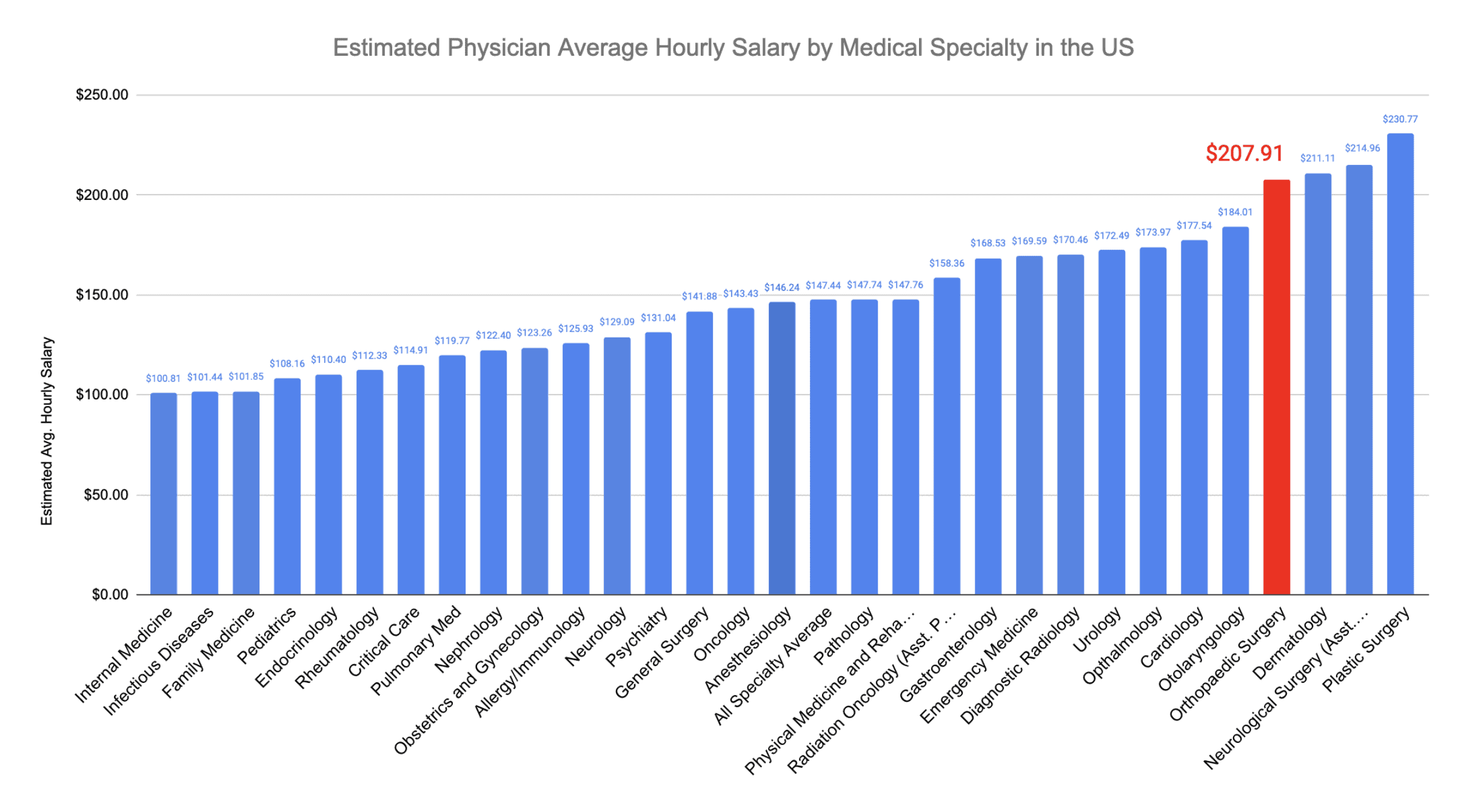
Orthopaedic Surgeons make roughly $207/hr on average when taking in hours worked per year
See this article for more on physician annual salaries and estimated hourly wage by specialty.
How Important is AOA for Orthopaedic surgery?
AOA – Alpha Omega Alpha – is the med school honors society. Each school may elect up to 20% of the graduating class of students.
Having AOA membership confers a greater advantage to matching into some specialties more than others. Often this AOA advantage is greatest for the most competitive specialties.
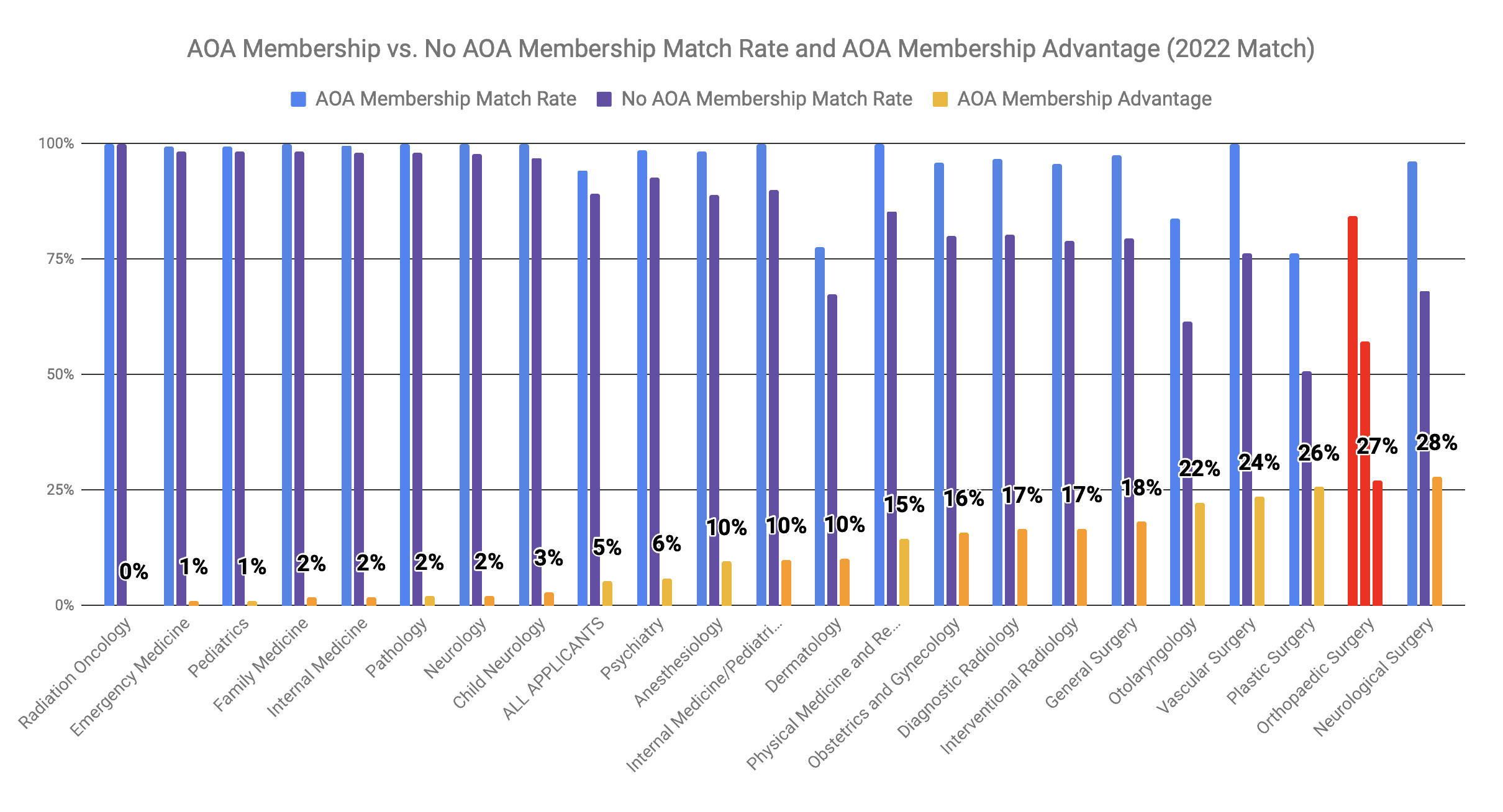
AOA membership correlated with a 27% match rate advantage for Orthopaedic Surgery in the 2022 Match
In the 2022 Match, the match rate for US seniors with AOA membership was 27% greater than that of US seniors without AOA membership. AOA membership provided a high advantage to matching into an orthopaedic surgery residency.
A number of schools do not have AOA chapters. Even in those schools, many of them rank students against each other. Regardless of AOA status, we can see that class rank is an important factor in successfully matching into orthopaedic surgery.
How Many Publications for Orthopaedic surgery Residency in 2022
Research is an important characteristic for matching into many specialties, particularly the most competitive. So, how many publications do you need to match into an orthopaedic surgery residency?
In 2022, the mean number of abstracts, presentations, and publications for US seniors who matched into orthopaedic surgery was 16.5. The mean number of research experiences was 6.6.
Do I Need an MD-PhD to Match Into Orthopaedic Surgery?
You may wonder how much an MD-PhD helps with matching into orthopaedic surgery. It appears that having a PhD correlates with a modest advantage of 7% when applying into orthopaedic surgery. Specifically, the match rate for those with a PhD is 7% higher than for those without one when applying into orthopaedic surgery.
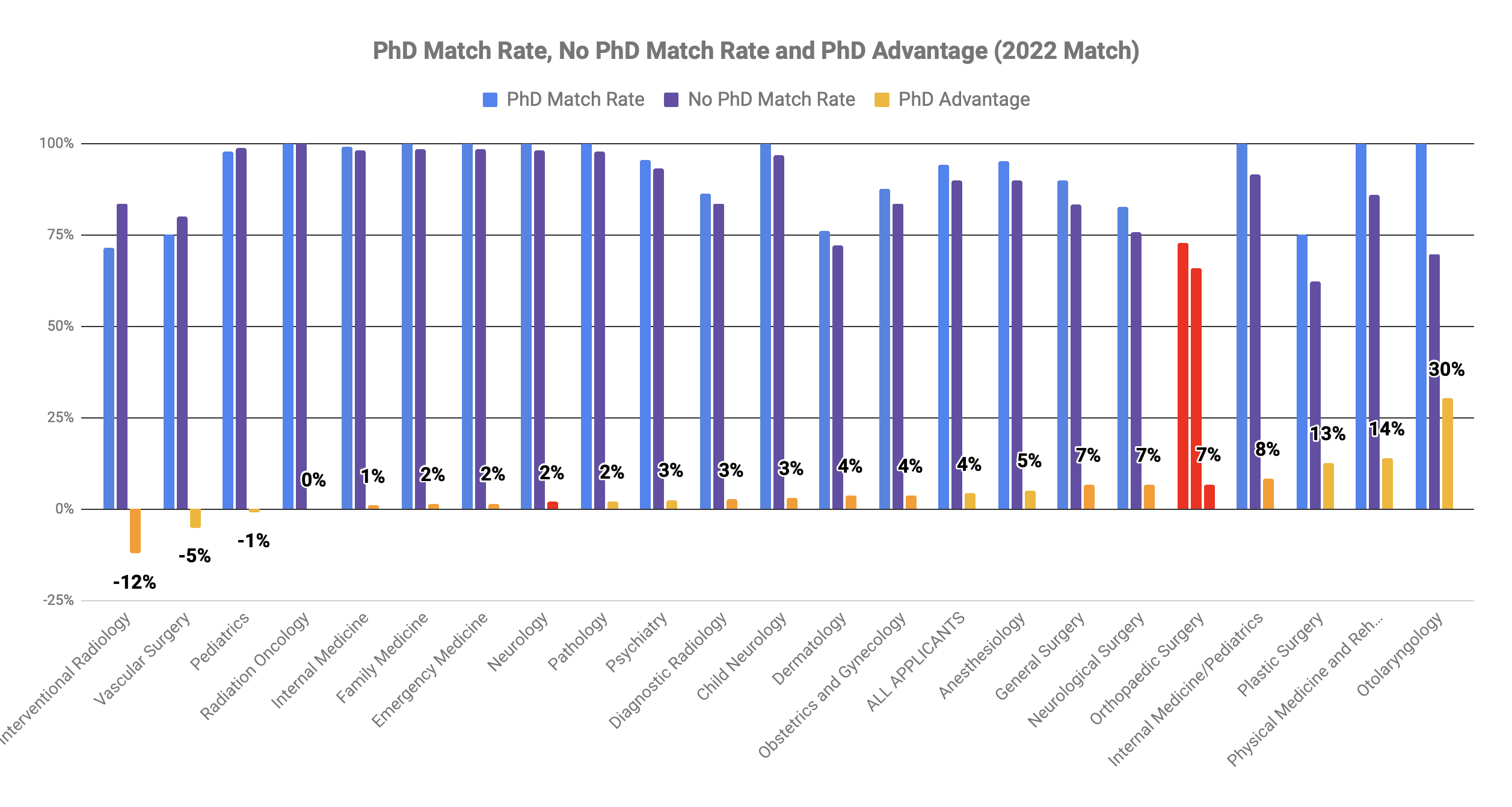
Having a PhD correlated with a 7% match rate advantage for Orthopaedic Surgery in the 2022 Match
Note that those with PhDs are moderately common among orthopaedic surgery residents. In fact, over 16% of matched applicants into orthopaedic surgery had a PhD in 2022 putting it among the highest ratios of all specialties.
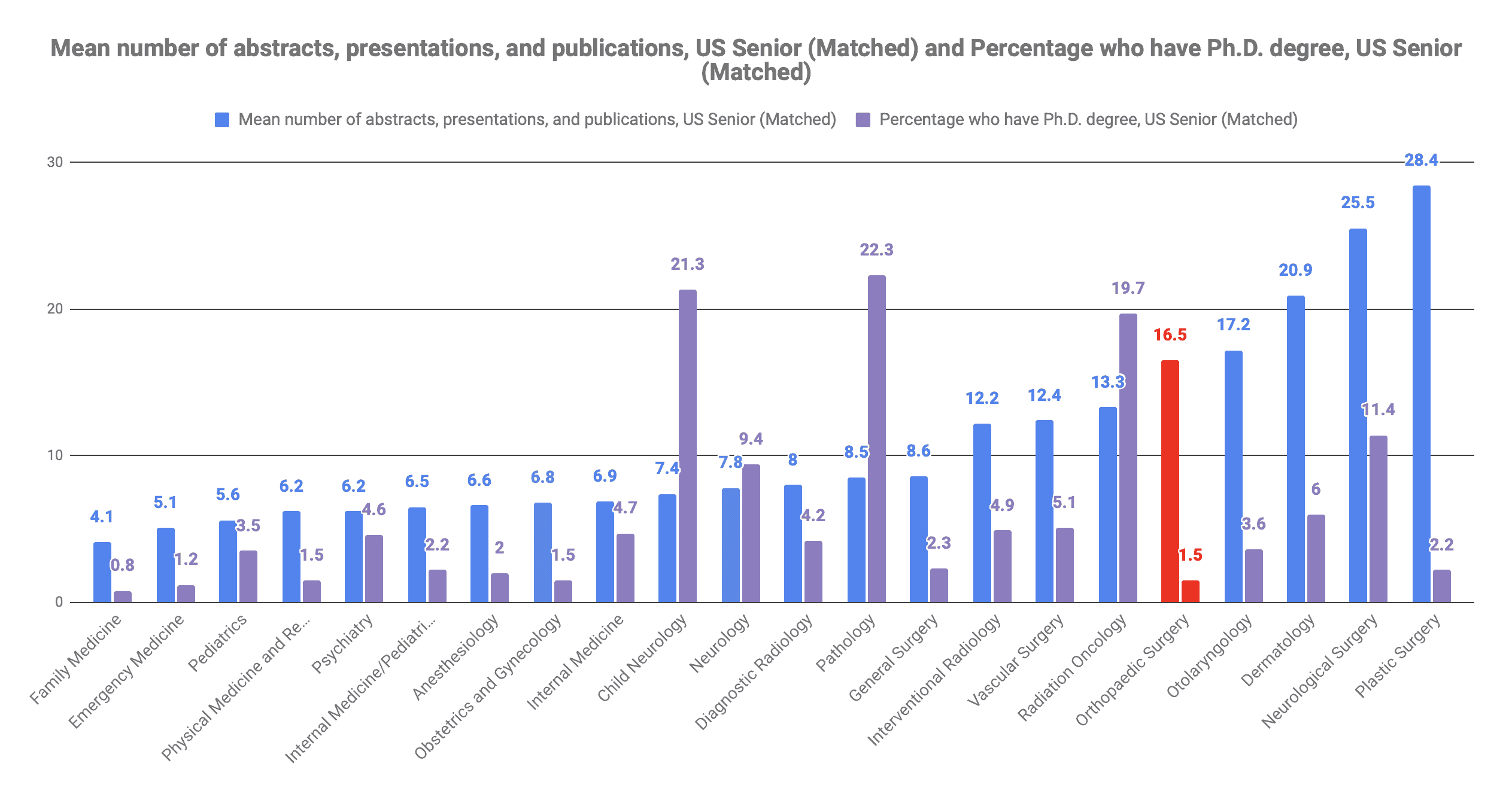
1.5% of matched applicants to Orthopaedic Surgery had an MD-PhD in 2022
Should You Attend a Top Medical School to Match Into Orthopaedic Surgery?
Does attending a top medical school help with matching into Orthopaedic Surgery? According to the program director survey results above, 36.1% of Orthopaedic Surgery PDs consider medical school reputation when considering whom to interview. The mean importance score was 3.4.
Similarly, we can look at the advantage to attending a school in the top 40 by NIH funding. In 2022, there was a 13% advantage in match rate to those attending a school in the top 40 for NIH funding vs. those who did not.
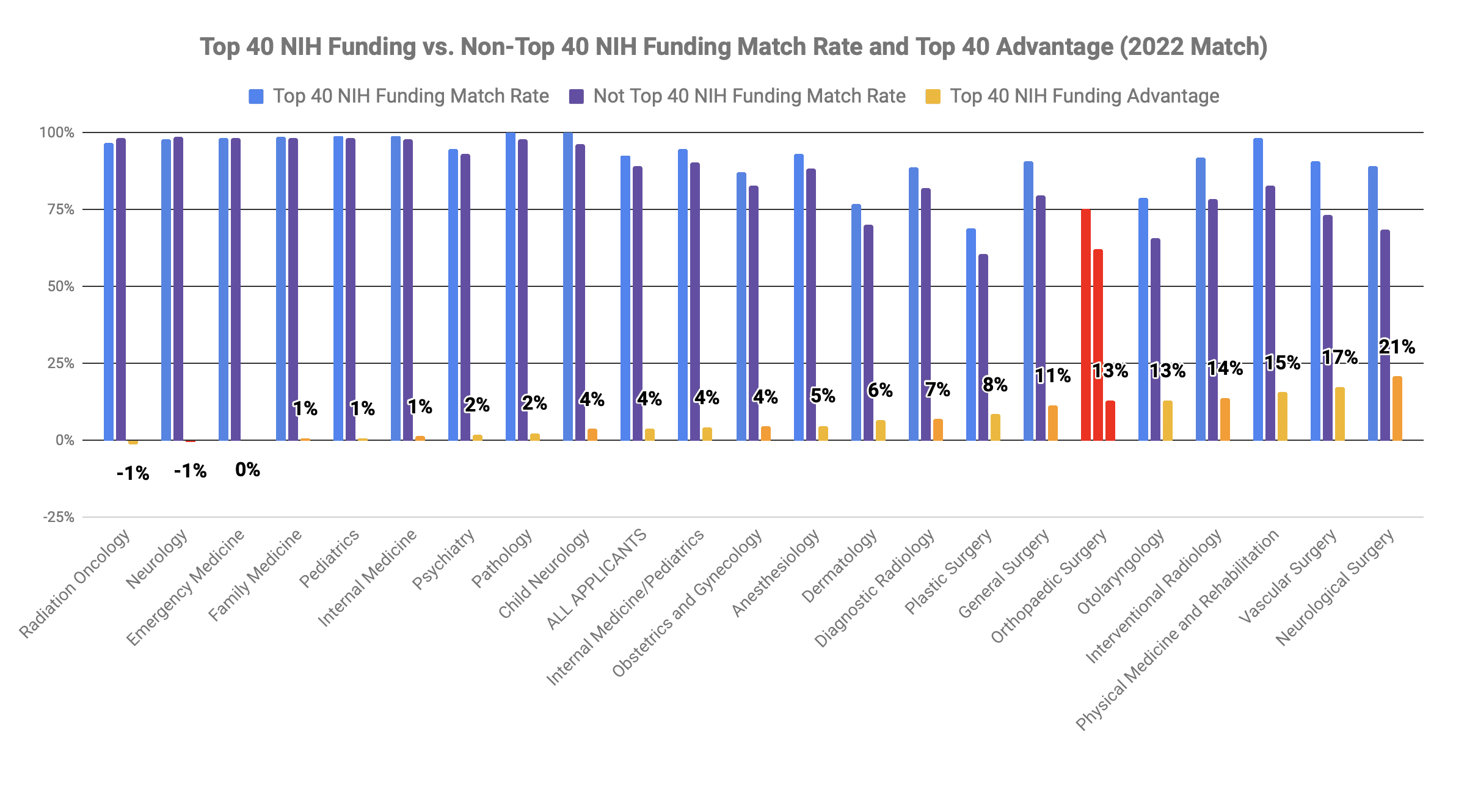
Graduating from a medical school ranked in the top 40 by NIH funding correlated with a 13% match rate advantage for Orthopaedic Surgery in the 2022 Match
Does an MPH or MBA Help Match Into Orthopaedic Surgery?
Medical training is long. Despite this, many consider – or complete – other degrees, like MPHs or MBAs.
But how much of an advantage – or disadvantage – does an MPH (Master of Public Health) or MBA (Master of Business Administration) confer when applying into orthopaedic surgery? Not much, it turns out. In fact, the match rate for US seniors with other degrees was 8% lower than the rate for those with other degrees.
These statistics imply that having a second degree that isn’t a PhD doesn’t appear to help your chances of matching into orthopaedic surgery, and may even hurt them (slightly).
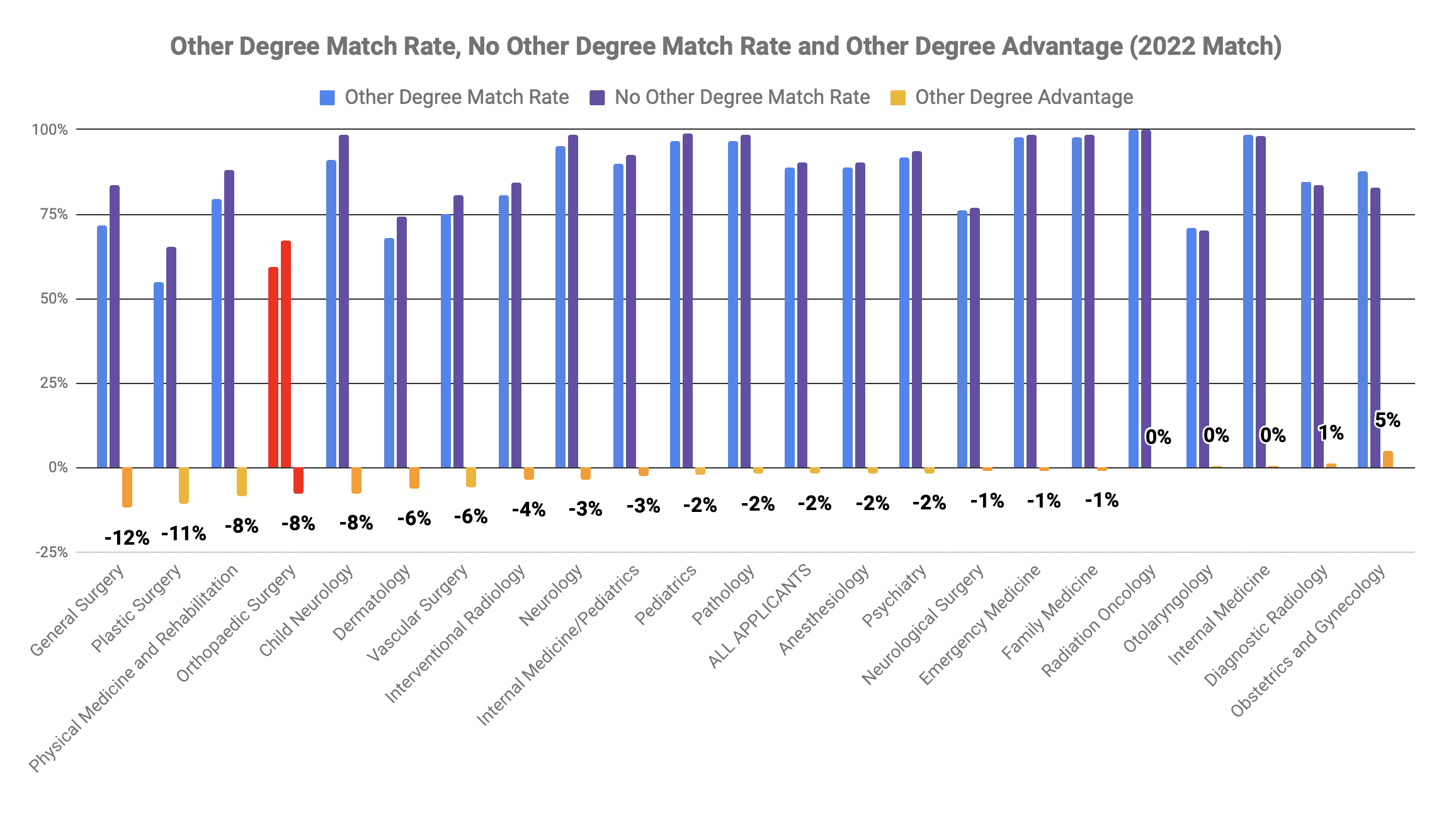
Having another degree like an MBA or MPH correlated with a -8% match rate disadvantage for Orthopaedic Surgery in the 2022 Match
What Are the Best Orthopaedic Surgery Programs?
While orthopaedic surgery may be moderately competitive, the most desirable programs will always be extremely difficult to enter. So which are the best orthopaedic surgery residency programs?
Opinions will vary. However, some of the most desirable orthopaedic surgery residency programs would include:
- Hospital for Special Surgery
- Mayo Clinic
- Cedars-Sinai Medical Center
- NYU Langone Orthopedic Hospital
- Midwest Orthopaedics
- Santa Monica-UCLA Medical Center
Concluding Thoughts
So how competitive is orthopaedic surgery in 2022? Based on the statistics, highly so. It is among the most competitive specialties. It requires moderate amounts of research, and extra credentials like AOA membership or an Ivy League education to match.
That said, orthopaedic surgery is highly competitive, particularly for the most desirable programs. While it is true for all specialties, USMLE scores – and particularly Step 2 CK – will be emphasized moving forward, particularly given how reliant orthopaedic surgery is on standardized screens to weed out applicants.
To learn more about how to master – not memorize – for impressive USMLE scores and higher class rankings, sign up for a free consultation. You can learn more about how Yousmle can help you to make the most of your time, to excel in your classes, Board exams, and the extracurriculars that are critical to matching.
Looking for an Orthopaedic Surgery Residency Advisor?
Looking for an orthopaedic surgery residency advisor? Want help writing your personal statement? Need effective strategies for interviewing? Do you have things on your application – e.g., low USMLE scores, failed USMLEs, no research, IMG status, or others – you need help overcoming?
Why Some Specialties are More Competitive

Ask any aspiring doctor and they will agree that some specialties are more competitive to get into than others. Ask them why, and you will get a variety of answers. What are the underlying factors that actually make a specialty competitive?
Defining What Makes a Specialty Competitive
Let’s start by defining what makes a specialty competitive.
The first thing that typically comes to mind is its match rate. Every couple of years, the National Residency Matching Program, or NRMP, posts data on the most recent residency application cycle.
They record a variety of different statistics, including the number of medical students that match into each specialty versus the total number of applicants to that specialty. This is referred to as that specialty’s match rate.
For most people, this is the holy grail of determining how competitive a specialty is. But it’s not all it’s chalked up to be.
Match rate alone is a very poor metric in determining a specialty’s competitiveness.
Is it helpful? Yes. Should we pay attention to it? Of course. But does it tell the full story? Absolutely not, and here’s why.
First, specialties are self-selecting, meaning that they attract a certain type of applicant.
If you’re not a competitive applicant, you’re not going to apply to something like dermatology or plastic surgery because you won’t get in. Plain and simple. So it’s in your best interest to only apply to specialties that you have a realistic chance at getting into.
Why does this matter when talking about match rates? Match rates don’t account for the fact that applicants are pre-screened before even applying.
For example, general surgery has a match rate of around 84%. In 2018, this was lower than plastic surgery’s 85%. But when you look at the average Step scores and other factors, in addition to the fact that many plastic surgery applicants use general surgery as a backup in case they can’t get into plastics, it becomes clear match rate alone isn’t a reliable indicator.
Another shortcoming of match rate that is often overlooked involves international medical graduates (IMGs).
Graduating medical students come from all over the world to finish their medical training in the U.S., and there are certain specialties that attract more IMGs than others. This is important because IMGs match into U.S. residencies at a far lower rate than U.S. graduates.
So, if a specialty attracts a large number of IMG applicants, it can make it difficult to compare to a specialty that doesn’t.
To overcome these shortcomings, I gathered data from the NRMP and organized it into a spreadsheet. I examined six categories of data: average match rate, Step 1 score, Step 2 CK score, number of publications, percentage of matriculants that were AOA, and percentage of applicants from a top 40 NIH-funded school.
What Factors Affect Supply?
Now that we’ve looked at the competitiveness of a specialty as it relates to applicant metrics, let’s look at it from a more macroeconomic perspective and explore the concepts of supply and demand.
Supply when referring to a specialty’s competitiveness refers to the number of open residency positions available. Specialties with few residency positions are generally more competitive than specialties with more residency positions. In essence, more residency positions equal more chances to get in.
The supply of residency positions for a given specialty is largely dictated by the societal demand for that specialty. Specialties like internal medicine have high societal demand.
Internal medicine physicians are the backbone of our hospital systems. They are often referred to as the quarterbacks of inpatient care. They manage the patient’s overall plan of care while in the hospital and often serve as the bridge between the patient and other consulting specialties.
Internal medicine is also a gateway into multiple fellowships including cardiology, gastroenterology, pulmonology, infectious diseases, hematology, oncology, nephrology, and more. Any physician wishing to pursue these specialties will have to go through internal medicine residency first.
For these reasons, our society needs a lot of physicians to go into internal medicine so the societal demand for internal medicine is high. According to the AAMC, there is approximately one internal medicine physician for every 2,800 people.
If we contrast this with something like plastic surgery that has less societal demand, there is approximately one plastic surgeon for every 45,000 people. I’m not saying plastic surgeons are not important, it’s just that objectively, there are fewer people that require the services of a plastic surgeon compared to an internist.
This is one of the contributing factors to plastic surgery being more competitive than internal medicine.
Additionally, the majority of funding for residency programs comes from the federal government through Medicare and Medicaid. Graduate medical education payments are made to teaching hospitals and health systems which then have control over how those funds are allocated.
The financial impact of residency training programs on these teaching hospitals and health systems is complex and not well understood; however, research has suggested that there are substantial differences in the financial impact of different specialties.
This means that hospitals may have incentives to fund residency positions for specialties that generate their facilities more revenue.
Internal medicine and its related services drive a large portion of a hospital’s revenue. For this reason, there is a financial incentive on the part of the hospital to fund IM residency positions. This may be another contributing factor to why IM has the largest number of residency positions by far.
This works in the reverse direction as well in that if a particular specialty does not generate the facility a lot of revenue, then there is a disincentive to adding residency positions for that specialty.
What Factors Affect Demand?
In addition to societal demand, demand can also refer to the number of medical students that want to go into a particular specialty. How desirable is that specialty to a medical student?
The primary factors that influence the desirability of a specialty are compensation and lifestyle. How much money do you make and how hard do you work to make it?
Many people will tell you that that money shouldn’t be a factor when becoming a doctor. Although this is true for most students when they enter medical school, by the time that they graduate, they often place a greater emphasis on the importance of lifestyle. For this reason, specialties that have a good lifestyle and high compensation like dermatology are typically seen as more desirable.
If we refer back to our competitiveness index, this may explain why dermatology is ranked as the #1 most competitive specialty. Additionally, plastic surgery, neurosurgery, and orthopedic surgery also ranked in the top 4 and just so happen to be the three highest compensated specialties.
Prestige is another factor that influences the desirability of a specialty – albeit to a lesser degree than compensation and lifestyle.
Some students are attracted to a particular specialty because of the respect and admiration they believe they will receive from others if they go into it. Surgical specialties in particular are often seen as more prestigious and coincidentally tend to be more competitive compared to non-surgical specialties.
Although this is an important factor for some, I would strongly recommend against letting it dictate your choice of specialty. Prestige is very externally focused. It takes the emphasis away from what you want and what you enjoy and places it on what other people think.
At the end of the day, going into a specialty that you actually enjoy will be far more important in your long-term happiness than the mental exercise of thinking which specialty has the best lifestyle, best compensation, or most prestige.
If you’re stuck deciding between specialties, be sure to check out our So You Want To Be playlist which contains comprehensive overviews of each specialty. Also check out my second channel, Kevin Jubbal, M.D. where we have day-in-the-life episodes for several medical specialties with more being added regularly.


